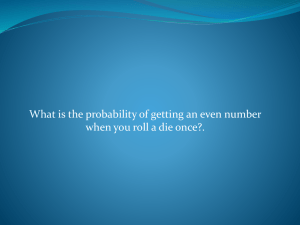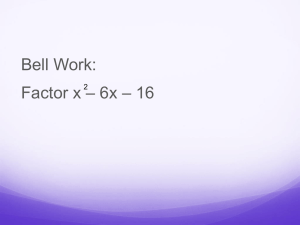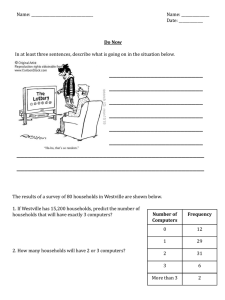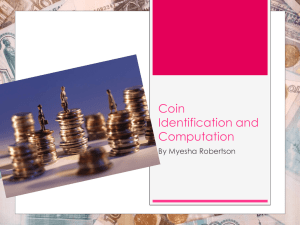Chapter 5
advertisement
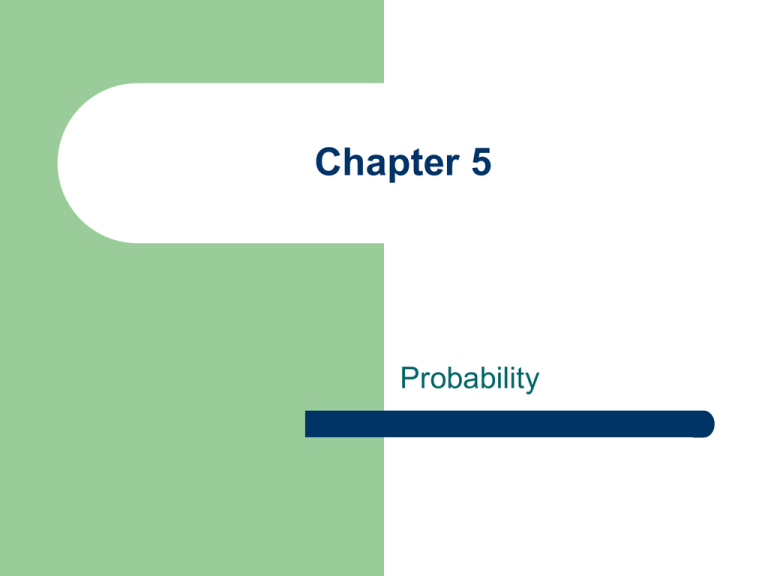
Chapter 5 Probability What You Will Learn To use tables and diagrams to organize outcomes To calculate probability To compare experimental and theoretical probability To predict the probability of events 5.1 – Probability (p. 158) After this lesson, you will be able to: – – Find the probability of an event in several different ways Give answers as probabilities from 0% to 100% Key Words Probability – – – Outcome – The likelihood or chance of an event occurring Probability = favourable outcomes possible outcomes Can be expressed as a ratio, fraction, or percent One possible result of a probability experiment Favourable outcome – A successful result in a probability experiment Ex #1: Represent Probabilities A spinner is divided into 4 equal sections. The spinner is spun once. Find the following probabilities. Write each answer as a fraction, a ratio, and a percent. Spinner a) What is the probability of spinning “orange”? – – – P(orange) is a short way to write “the probability of – ‘orange’ occurring.” There are only 4 possible outcomes: red, orange, blue, and green. Probability = favourable outcomes = orange possible outcomes all colours P(orange) = ¼ ¼ can be written as the = 0.25 ratio 1:4. = 0.25 x 100% = 25% The probability of spinning “orange” is ¼, 1:4, or 25%. Spinner b) What is the probability of spinning a primary colour (red/blue/yellow)? – – – There are two primary colours (red and blue) on the spinner, so there are two favourable outcomes. P(red or blue) = favourable outcomes = red or blue possible outcomes all colours = 2/4 = 0.5 = 0.5 x 100% = 50 % The probability of spinning a primary colour is 2/4, 2:4, or 50% Spinner c) What is the probability of spinning “brown”? – The colour brown is not represented on the spinner. Therefore, there are no favourable outcomes. – P(brown) = favourable outcomes = brown possible outcomes all colours = 0/4 This is an impossible event. =0% The probability of spinning “brown” is 0/4, 0:4, or 0%. – Assignment, Part I Show You Know, p. 160 P. 162, #1 – 3 Ex #2: Determine Probabilities A bag contains 10 marbles. Show the probability of the following events as a fraction, a ratio, and a percent. Marble Bag a) Selecting a red marble – – – There are 10 possible outcomes. There are 6 red marbles, so there are 6 favourable outcomes. P(red) = favourable outcomes possible outcomes = 6/10 = 60% The probability of selecting a red marble is 6/10, 6:10, or 60%. Marble Bag b) Selecting a red or blue or green marble – – P(red or blue or green ) = 10/10 =1 = 100% The probability of selecting a red or blue or green marble is 10/10, 10:10, or 100%. Marble Bag c) Not selecting a red marble – – – The probability of not selecting a red marble is the same as the probability of selecting a blue or green marble. P(not red) = P(blue or green ) = 4/10 = 40% The probability of selecting a marble that is not red is 4/10, 4:10, or 40%. Assignment, Part II Show You Know, p. 161 P. 163, #5 Bowl of Jellybeans Key Ideas, p. 162 Probability – The likelihood or chance of an event occurring – Probability = favourable outcomes possible outcomes – P(red) = . . Probability can be expressed as a ratio, fraction, or percent. – P(red) = 5 or 5:10 or 50% 10 The probability of an impossible event is 0 or 0%. – P(yellow) = 0 or 0:10 or 0% 10 The probability of a certain event is 1 or 100%. – P(jellybean) = 10 or 10:10 or 100% 10 Assignment, Part III P. 163, #7, 9, 10 No prob? Try #11 & 12 Math Link! 5.2 – Organize Outcomes (p. 165) After this lesson, you will be able to: – – – Explain how to identify an independent event Determine the outcomes of two independent events Organize outcomes of two independent events using tables and tree diagrams. Don’t write this down. Discuss the Math* (p. 165) Value of First Coin Value of Second Coin Sum 25 ¢ 25 ¢ 50 ¢ 25 ¢ 10 ¢ 35 ¢ 25 ¢ 5¢ 30 ¢ 25 ¢ 1¢ 26 ¢ 10 ¢ 25 ¢ 35 ¢ 10 ¢ 10 ¢ 20 ¢ 10 ¢ 5¢ 15 ¢ 10 ¢ 1¢ 11 ¢ 5¢ 25 ¢ 30 ¢ 5¢ 10 ¢ 15 ¢ 5¢ 5¢ 10 ¢ 5¢ 1¢ 6¢ 1¢ 25 ¢ 26 ¢ 1¢ 10 ¢ 11 ¢ 1¢ 5¢ 6¢ 1¢ 1¢ 2¢ *see “Notes” Discuss the Math 2a) How many possible combinations are there? Solution: 16 b) How many combinations have an even sum? Solution: 10 c) How many combinations have an odd sum? Solution: 6 Discuss the Math 3a) What is the probability that Payam will have to do Maryam’s chores? Solution: 10/16 or 0.625 or 62.5% b) What is the probability that Maryam will have to do Payam’s chores? Solution: 6/16 or 0.375 or 37.5% Reflect on Your Findings 4a) How do you know that the table includes all possible combinations of coins? One possible solution: We systematically recorded the outcomes. Our system involved listing the greatest-valued coin first, followed by all the possible coins pulled on the second pull. Then we listed the second greatest-valued coin, followed by all the possible coins pulled on the second pull. We did the same for the third- and fourth-greatest coin. – – We did NOT just write down the possible outcomes at random. In other words, we used a system to record the possible outcomes. Reflect on Your Findings 4b) How does identifying all the possible outcomes help you determine the probability of the favourable outcome? One possible solution: We can actually see the number of times a favourable outcome occurs. We can use this number to determine the probability of the favourable outcome occurring. c) Should Payam agree to Maryam’s conditions? What advice would you give Payam about playing this game with his sister? (See #2 and 3) Write this down. Key Words Independent events – The outcome of one event has no effect on the outcome of another event Sample space – All possible outcomes of an experiment Coin: Heads, Tails 6-sided die: 1, 2, 3, 4, 5, 6 Tree Diagram – – A diagram used to organize outcomes Contains a branch for each possible outcome of an event Ex #1: Represent Outcomes With a Table A coin is flipped and a six-sided die is rolled. These two events are called independent events. Coin / Six-sided die a) Use a table to list all the possible outcomes. Solution: Die 1 b) 2 3 4 5 6 Coin Heads (H) H, 1 H, 2 H, 3 H, 4 H, 5 H, 6 Flip T, 1 T, 2 T, 5 T, 6 Tails (T) T, 3 T, 4 How many possible outcomes are there? Solution: – From the table, there are 12 possible outcomes. Coin / Six-sided die c) Write the sample space for this combination of events. Solution: The sample space is (H, 1), (H, 2), (H, 3), (H, 4), (H, 5), (H, 6), (T, 1), (T, 2), (T, 3), (T, 4), (T, 5), (T, 6) Assignment, Part I Show You Know, p. 166 P. 168, #1, 3, 4 Ex #2: Represent Outcomes With a Tree Diagram A coin is flipped and the spinner is spun once. Elk Bear Salmon Elk Coin / 3-Outcome Spinner A) Create a tree diagram that shows all the possible outcomes. Solution: Coin Flip Spinner Outcome Bear H, Bear Elk H, Elk Heads Salmon H, Salmon Tails Bear T, Bear Elk T, Elk Salmon T, Salmon Bear Salmon You don’t need to write this down. Reading Tree Diagrams Read tree diagrams from left to right. – – – The branches on the left of the tree show the outcomes for the coin flip. The branches on the right show the outcomes for the spinner. The column on the far right of the diagram lists the combined outcomes. Coin Flip Spinner Outcome Bear H, Bear Elk H, Elk Heads Salmon H, Salmon Tails Bear T, Bear Elk T, Elk Salmon T, Salmon You DO need to write this down. Coin / 3-Outcome Spinner Elk Bear Salmon B) List the sample space for these two events. Solution: The sample space is (H, Bear), (H, Elk), (H, Salmon), (T, Bear), (T, Elk), (T, Salmon) Write each outcome in the space as an ordered pair. Elk Bear Salmon Coin / 3-Outcome Spinner C) Think of another diagram that could be used to show the outcomes. Solution: One possible diagram is shown. This diagram is called a “spider diagram.” Bear Bear Elk Elk Salmon Salmon Assignment, Part II Show You Know, p. 167 P. 168, #2, 6 Key Ideas Two events are independent if the outcome of one has no effect on the outcome of the other event. When you roll a die, it is not affected by another die being rolled beside it. You can create tables, tree diagrams, and other diagrams to organize the outcomes for two independent events. Something To Think About Many students (and adults) do not realize that if a fair die is rolled five times and the number 6 appears each time, the likelihood of the number 6 appearing on the next roll is still 1/6 (no more and no less). – Each and every time I roll the die, I have a 1 in 6 chance of rolling a 6. Assignment, Part III P. 168, #8 No prob? Try #10, 11, 12 Math Link, p. 170 Pro star? Try # 13 5.3 Probabilities of Simple Independent Events (p. 171) After this lesson, you will be able to: – Solve probability problems involving two independent events. Key Words Random – An event in which every outcome has an equal chance of occurring. Ex #1: Use a Tree Diagram to Determine Probabilities (p. 172) A school gym has three doors on the stage and two back doors. During a school play, each character enters through one of the five doors. The next character to enter can be either a boy or a girl. Stage Gym Boy/Girl Entering Through Doors a) Draw a tree diagram to show the sample space. Stage Gender Boy Gym b) What is P(boy, centre stage door)? Show your answer as a fraction and as a percent. Girl Door Outcome Back left Boy, Back left Back right Boy, Back right Left stage Boy, Left stage Centre stage Boy, Centre stage Right stage Boy, Right stage Back left Girl, Back left Back right Girl, Back right Left stage Girl, Left stage Centre stage Girl, Centre stage Right stage Girl, Right stage Boy/Girl Entering Through Doors b) What is P(boy, centre stage door)? Show your answer as a fraction and as a percent. Solution: – – – – There are 10 possible outcomes. There is 1 favourable outcome. Probability = favourable outcomes possible outcomes P(boy, centre stage door) = 1/10 = 0.1 = 10% The probability of a boy entering through the middle door is 1/10 or 10%. Ex #2: Use a Table to Determine Probabilities A marble is randomly selected from a bag containing one blue, one red, and one green marble. Then, a four-sided die labelled 1, 2, 3, and 4 is rolled. 3 Marbles and a 4-Sided Die A) Create a table to show the sample space. Die 1 2 3 4 Blue(B) B, 1 B, 2 B, 3 B, 4 Marble Red (R) R, 1 R, 2 R, 3 R, 4 Green (G) G, 1 G, 2 G, 3 G, 4 You can use short forms of words in probability diagrams and tables. Here, blue, red, and green have become B, R, and G. You might make up your own abbreviations for an organizer, but write the full words for your final answers. 3 Marbles and a 4-Sided Die B) What is the probability of choosing any colour, and rolling any number but 3? Solution: - To find each probability, count the favourable outcomes and divide by the total number of outcomes. Die 1 Marble 2 3 4 Blue(B) B, 1 B, 2 B, 3 B, 4 Red (R) R, 1 R, 2 R, 3 R, 4 Green (G) G, 1 G, 2 G, 3 G, 4 • P(any colour, any number but 3) = 9/12 = 0.75 = 75% 3 Marbles and a 4-Sided Die C) What is P(blue or green, a number greater than 1)? Solution: - To find each probability, count the favourable outcomes and divide by the total number of outcomes. Die 1 Marble 2 3 4 Blue(B) B, 1 B, 2 B, 3 B, 4 Red (R) R, 1 R, 2 R, 3 R, 4 Green (G) G, 1 G, 2 G, 3 G, 4 • P(blue or green, a number greater than 1) = 6/12 = 0.5 = 50% 3 Marbles and a 4-Sided Die D) What is P(black, 1)? Solution: -To find each probability, count the favourable outcomes and divide by the total number of outcomes. • There is no black marble. • P(black, 1) = 0/12 =0 = 0% Die 1 Marble 2 3 4 Blue(B) B, 1 B, 2 B, 3 B, 4 Red (R) R, 1 R, 2 R, 3 R, 4 Green (G) G, 1 G, 2 G, 3 G, 4 This is known as a/an impossible __________ event. 3 Marbles and a 4-Sided Die E) What is the probability that a red or green or blue marble is selected and the die displays a 4? Solution: - To find each probability, count the favourable outcomes and divide by the total number of outcomes. • P(red or green or blue, 4) Die 1 Marble 2 3 4 Blue(B) B, 1 B, 2 B, 3 B, 4 Red (R) R, 1 R, 2 R, 3 R, 4 Green (G) G, 1 G, 2 G, 3 G, 4 = 3/12 = 0.25 = 25% Purple Yellow Key Ideas You can use a tree diagram, table, or other organizer to help determine probabilities. Count the favourable outcomes and divide by the total number of possible outcomes to find the probability. Red Coin Colour Purple H Yellow Red Purple T Yellow Red P P Y H T Y R R Purple Yellow Red Heads H, purple H, yellow H, red Tails T, purple T, yellow T, purple P(heads, purple) = 1/6 Assignment P. 175, #1-2 (as a class), 3, 4, 6, 8, 9 Still good? P. 176, #10 & 11, 13. Pro star? # 14 & 15 5.4 - Applications of Independent Events After this lesson, you will be able to: – Use tree diagrams, tables, and other graphic organizers to solve probability problems. Ex#1: Interpret Outcomes in a Tree Diagram 1 A 2 3 4 a) Look at the tree diagram. 1 A 2 3 Describe or draw a spinner and a die that would produce the possible outcomes shown. 4 1 B 2 3 Solution: 4 1 A A C C 2 3 4 B C 1 C 2 3 4 Ex#1: Interpret Outcomes in a Tree Diagram 1 A 2 3 4 b) What is P(B, 2)? 1 A Solution: By counting the branches in the right column, there are 20 possible outcomes. All 20 outcomes are equally likely (random). There is only one favourable outcome. – P(B, 2) = 1/20 = 0.05 = 5% 2 3 4 1 B 2 3 4 1 C 2 3 4 1 C 2 3 4 Ex#1: Interpret Outcomes in a Tree Diagram 1 A 2 3 4 b) What is the probability of getting an A and a 3? 1 A 2 3 Solution: There are two favourable outcomes. – P(A, 3) 4 1 B = 2/20 = 0.1 = 10% 2 3 4 1 C 2 3 4 1 C 2 3 4 Ex#1: Interpret Outcomes in a Tree Diagram 1 A 2 3 4 b) What is the probability of getting a C and a number less than 4? 1 A 2 3 Solution: There are 3 numbers less than 4: 1, 2, and3. For each of these numbers, there are two possible regions labelled C. By counting, there are 6 favourable outcomes. – P(C, less than 4) 4 1 B 2 3 4 1 C 2 3 = 6/20 = 0.3 = 30% 4 1 C 2 3 4 Key Ideas Tables and tree diagrams can be useful tools for organizing the outcomes of complex independent events. Assignment With ONE partner: p. 180, #1-2 On your own: p. 181, #3, 5, 7. No prob? Try #8. Pro star? Try #10-11 5.5 - Conduct Probability Experiments After this lesson, you will be able to: – – Conduct a probability experiment and organize the results Compare experimental probability with theoretical probability. Explore the Math P. 183 #5a) Spin 1 Y Y Y N #5b) – 9/16 or 56.25% Y Y,Y Y,Y Y,Y N,Y Spin 2 Y Y Y,Y Y,Y Y,Y Y,Y Y,Y Y,Y N, Y N, Y N Y,N Y,N Y,N N, N Key Terms Experimental Probability – The probability of an event based on experimental results Theoretical Probability – The expected probability of an event ocurring Ex#1: Compare Theoretical and Experimental Probability (p. 184) A) From the data, what is the experimental probability of taking two left turns? – Solution: P(2 lefts) = 22/100, 0.22, 22% B) What is the theoretical probability of taking 2 left H H turns? – P(2 lefts) = ¼, 0.25, 25% T Solution: T H T C) Compare the experimental probability with the theoretical probability. – Solution: 25% > 22%. The theoretical probability is greater than the experimental probability. Assignment Part I P. 185, Show You Know, as a class. – – Copy chart into notes: Coin Flip P. 187, #4 Coin Outcomes H, H (two lefts) H, T (left, right) T, H (right left) T, T (two rights) Experimental Results Number of Results Ex #2: Compare Experimental and Theoretical Probability Using Technology (p. 185) Go through as a class – A) What is the experimental probability of getting children of two different genders? Solution – On the spreadsheet, a family with two different genders appears as either 0, 1 or 1, 0. Experimental P(boy and girl) = 11/20, 0.55, or 55% Ex #2: Compare Experimental and Theoretical Probability Using Technology (p. 185) – B) What is the theoretical probability of getting B B children of two different genders? Solution G G B G – – Theoretical P(boy and girl) = 10/20, 0.50, or 50% C) Compare the experimental probability with the theoretical probability. Solution – 55% > 50%. The experimental probability is greater than the theoretical probability. Assignment Part II Show You Know, p. 186, as a class – A) What is your experimental probability of getting two boys? B Random Number Generator B G G B G – B) What is the theoretical probability of getting two boys? – ¼ or 25% C) Compare the experimental and theoretical probabilities. On your own, p. 187, #6 Key Ideas The probability of an event determined from experimental outcomes is called experimental probability. Experimental outcomes are usually collected in a tally chart and counted at the end of the experiment. The probability of an event determined from a list of all possible outcomes is called theoretical probability. Experimental probability and theoretical probability are NOT always the same. Flip two loonies 10 times. Coin Outcomes Experimental Results Number of Results H, H II 2 H, T IIII I 6 T, H I 1 T, T I 1 H H T T H T •Experimental P(T, T) = 1/10 •Theoretical P(T, T) = 0.10 or 10% = 1/4 = 0.25 or 25% Assignment Part III P. 187, #8 No prob? Try #9-11 Pro star? Try #12-13 Tomorrow: Chapter 5 Review & Practice Test
